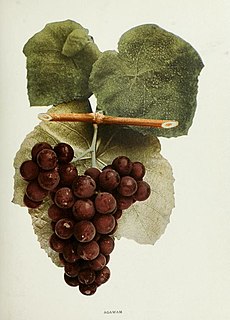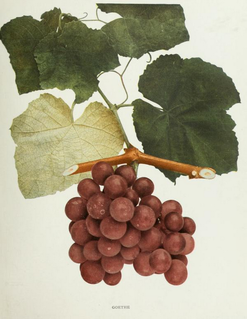
Aurore is a white complex hybrid grape variety produced by Albert Seibel and used for wine production mostly in the United States and Canada. Over a long lifetime Seibel produced many complex hybrid crosses of Vitis vinifera to American grapes. It is a cross of Seibel 788 and Seibel 29.

Agawam is a hybrid grape variety. It is a crossing of Carter and Muscat Hamburg. Agawam is one of the so-called Rogers' Hybrids created by E.S. Rogers in the early-to-mid-19th century, and is unique among the named cultivars of that group in that it is self-fertile.

Vitis labrusca, the fox grape, is a species of grapevines belonging to the Vitis genus in the flowering plant family Vitaceae. The vines are native to eastern North America and are the source of many grape cultivars, including Catawba, Concord, Delaware, Isabella, Niagara, and many hybrid grape varieties such as Agawam, Alexander and Onaka. Among the characteristics of this vine species in contrast to the European wine grape Vitis vinifera are its "slip-skin" that allows the skin of the grape berries to easily slip off when squeezed, instead of crushing the pulp, and the presence of tendrils on every node of the cane. Another contrast with European vinifera is the characteristic "foxy" musk of V. labrusca, best known to most people through the Concord grape. This musk is not related to the mammalian fox, but rather to the strong, earthy aromas characteristic of the grapes that were known by early European-American settlers in the New World. The term "foxy" became a sort of catchall for the wine tasting descriptors used for these American wines that were distinct from the familiar flavors of the European viniferous wines.

Vitis riparia Michx, with common names riverbank grape or frost grape, is a native American climbing or trailing vine, widely distributed across central and eastern Canada and the central and northeastern parts of the United States, from Quebec to Texas, and eastern Montana to Nova Scotia. There are reports of isolated populations in the northwestern USA, but these are probably naturalized. It is long-lived and capable of reaching into the upper canopy of the tallest trees. It produces dark fruit that are appealing to both birds and people, and has been used extensively in commercial viticulture as grafted rootstock and in hybrid grape breeding programs.

Vitis rupestris is a species of grape native to the United States that is known by many common names including July, Coon, sand, sugar, beach, bush, currant, ingar, rock, and mountain grape. It is used for breeding several French-American hybrids as well as many root stocks. The cultivar known as Rupestris St. George has been widely used in breeding and as a root stock; it is perhaps the best known.
Vitis × labruscana is a subgroup of grapes originating from a hybridization of Vitis labrusca and other species, most commonly Vitis vinifera. Popular examples include Concord and Niagara grapes, which comprise nearly all grapes processed for juice or jelly in the United States. Such cultivars are frequently referred to as "labrusca", however many are as little as half Vitis labrusca in their pedigree. Another common term, arguably more accurate, is "labrusca-type". These varieties do in fact possess many of the traits of Vitis labrusca, frequently including slipskin fruit, strong "foxy" flavor/odor, and large leaves with lighter colored and pubescent undersides. Most are self-fertile, unlike wild Vitis labrusca.

Hybrid grapes are grape varieties that are the product of a crossing of two or more Vitis species. This is in contrast to crossings between grape varieties of the same species, typically Vitis vinifera, the European grapevine. Hybrid grapes are also referred to as inter-specific crossings or "Modern Varieties." Due to their often excellent tolerance to powdery mildew, other fungal diseases, nematodes, and phylloxera, hybrid varieties have, to some extent, become a renewed focus for European breeding programs. The recently developed varieties, Rondo, and Regent are examples of newer hybrid grape varieties for European viticulturalists. Several North American breeding programs, such as those at Cornell and the University of Minnesota, focus exclusively on hybrid grapes, with active and successful programs, having created hundreds if not thousands of new varieties.

Goethe is one of the collection of grape varieties known as Rogers' Hybrids, created by E.S. Rogers in the mid-19th century, and is the result of a cross of Carter, a selection of Vitis labrusca, and Black Hamburg, a selection of Vitis vinifera. It was originally known as Rogers No. 1, until Rogers named it after Johann Wolfgang Goethe, the German author, artist, and scientist.
Orion is a white wine grape variety of German origin. It was created by Dr. Gerhardt Alleweldt (1927-2005) at the Geilweilerhof Institute for Grape Breeding in Siebeldingen in 1964, by crossing the Vitis vinifera variety Optima with the hybrid grape Villard Blanc. Therefore, Orion is itself a hybrid grape rather than a pure Vitis vinifera.

Vitis berlandieri is a species of grape native to the southern North America, primarily Texas, New Mexico and Arkansas.
Alexander is a spontaneous cross of vines from which the first commercial wines in America were made. It was discovered in 1740 in the neighborhood of Springgettsbury, Philadelphia, in a vineyard where James Alexander, Thomas Penn's gardener, had originally planted cuttings of Vitis vinifera in 1683. It was popularized by the Bartram family at Bartram's Garden, Philadelphia, and widely distributed after the American Revolution by William Bartram.
Black Spanish is now known to be a seedling of an American hybrid grape resulting from a cross of the American Vitis aestivalis species of grape with an unknown Vitis vinifera pollen donor. This hybridization is not known to have been purposeful, and may have occurred naturally, as was the case with many of the early American grape cultivars.
Vitis silvestrii is a species of polygamo-dioecious plant in the grape family native to the forested slopes of western Hubei and southern Shaanxi in China from 300 to 1200 meters above sea level. Its flowers appear in May, males having abortive pistils

Olmo grapes are wine and table grape varieties produced by University of California, Davis viticulturist Dr. Harold Olmo. Over the course of his nearly 50-year career, Dr. Olmo bred a wide variety of both grapes by means of both crossing varieties from the same species or creating hybrid grapes from cultivars of different Vitis species.
Royalty is a rouge Californian wine grape variety that was developed in 1938 by Dr. Harold P. Olmo of the University of California, Davis. The grape is a red fleshed teinturier which, unlike most red wine grapes, will produced red-tinged colored wine even without maceration time on the skins. The grape is a hybrid being produced from the Vitis vinifera Trousseau gris variety from the Jura wine region of France and the teinturier grape Alicante Ganzin that, itself, is a hybrid of a Vitis rupestris variety and the Vitis vinifera grape Aramon.

L'Acadie blanc is a white Canadian wine grape variety that is a hybrid crossing of Cascade and Seyve-Villard 14-287. The grape was created in 1953 by grape breeder Ollie A. Bradt in Niagara, Ontario at the Vineland Horticultural Research Station which is now the Vineland Research and Innovation Centre. Today the grape is widely planted in Nova Scotia with some plantings in Quebec and Ontario. Some wine writers, including those at Appellation America, consider L'Acadie blanc as "Nova Scotia’s equivalent to Chardonnay".













